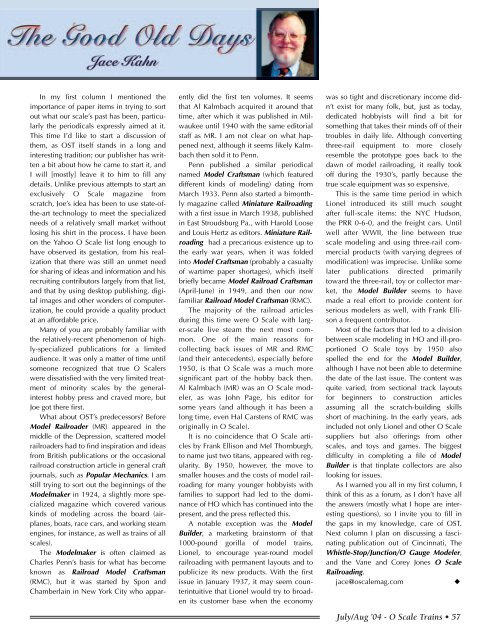Scale - O Scale Trains Magazine Online
Scale - O Scale Trains Magazine Online
Scale - O Scale Trains Magazine Online
You also want an ePaper? Increase the reach of your titles
YUMPU automatically turns print PDFs into web optimized ePapers that Google loves.
In my first column I mentioned theimportance of paper items in trying to sortout what our scale’s past has been, particularlythe periodicals expressly aimed at it.This time I’d like to start a discussion ofthem, as OST itself stands in a long andinteresting tradition; our publisher has writtena bit about how he came to start it, andI will [mostly] leave it to him to fill anydetails. Unlike previous attempts to start anexclusively O <strong>Scale</strong> magazine fromscratch, Joe’s idea has been to use state-ofthe-arttechnology to meet the specializedneeds of a relatively small market withoutlosing his shirt in the process. I have beenon the Yahoo O <strong>Scale</strong> list long enough tohave observed its gestation, from his realizationthat there was still an unmet needfor sharing of ideas and information and hisrecruiting contributors largely from that list,and that by using desktop publishing, digitalimages and other wonders of computerization,he could provide a quality productat an affordable price.Many of you are probably familiar withthe relatively-recent phenomenon of highly-specializedpublications for a limitedaudience. It was only a matter of time untilsomeone recognized that true O <strong>Scale</strong>rswere dissatisfied with the very limited treatmentof minority scales by the generalinteresthobby press and craved more, butJoe got there first.What about OST’s predecessors? BeforeModel Railroader (MR) appeared in themiddle of the Depression, scattered modelrailroaders had to find inspiration and ideasfrom British publications or the occasionalrailroad construction article in general craftjournals, such as Popular Mechanics. I amstill trying to sort out the beginnings of theModelmaker in 1924, a slightly more specializedmagazine which covered variouskinds of modeling across the board (airplanes,boats, race cars, and working steamengines, for instance, as well as trains of allscales).The Modelmaker is often claimed asCharles Penn’s basis for what has becomeknown as Railroad Model Craftsman(RMC), but it was started by Spon andChamberlain in New York City who apparentlydid the first ten volumes. It seemsthat Al Kalmbach acquired it around thattime, after which it was published in Milwaukeeuntil 1940 with the same editorialstaff as MR. I am not clear on what happenednext, although it seems likely Kalmbachthen sold it to Penn.Penn published a similar periodicalnamed Model Craftsman (which featureddifferent kinds of modeling) dating fromMarch 1933. Penn also started a bimonthlymagazine called Miniature Railroadingwith a first issue in March 1938, publishedin East Stroudsburg Pa., with Harold Looseand Louis Hertz as editors. Miniature Railroadinghad a precarious existence up tothe early war years, when it was foldedinto Model Craftsman (probably a casualtyof wartime paper shortages), which itselfbriefly became Model Railroad Craftsman(April-June) in 1949, and then our nowfamiliar Railroad Model Craftsman (RMC).The majority of the railroad articlesduring this time were O <strong>Scale</strong> with larger-scalelive steam the next most common.One of the main reasons forcollecting back issues of MR and RMC(and their antecedents), especially before1950, is that O <strong>Scale</strong> was a much moresignificant part of the hobby back then.Al Kalmbach (MR) was an O <strong>Scale</strong> modeler,as was John Page, his editor forsome years (and although it has been along time, even Hal Carstens of RMC wasoriginally in O <strong>Scale</strong>).It is no coincidence that O <strong>Scale</strong> articlesby Frank Ellison and Mel Thornburgh,to name just two titans, appeared with regularity.By 1950, however, the move tosmaller houses and the costs of model railroadingfor many younger hobbyists withfamilies to support had led to the dominanceof HO which has continued into thepresent, and the press reflected this.A notable exception was the ModelBuilder, a marketing brainstorm of that1000-pound gorilla of model trains,Lionel, to encourage year-round modelrailroading with permanent layouts and topublicize its new products. With the firstissue in January 1937, it may seem counterintuitivethat Lionel would try to broadenits customer base when the economywas so tight and discretionary income didn’texist for many folk, but, just as today,dedicated hobbyists will find a bit forsomething that takes their minds off of theirtroubles in daily life. Although convertingthree-rail equipment to more closelyresemble the prototype goes back to thedawn of model railroading, it really tookoff during the 1930’s, partly because thetrue scale equipment was so expensive.This is the same time period in whichLionel introduced its still much soughtafter full-scale items: the NYC Hudson,the PRR 0-6-0, and the freight cars. Untilwell after WWII, the line between truescale modeling and using three-rail commercialproducts (with varying degrees ofmodification) was imprecise. Unlike somelater publications directed primarilytoward the three-rail, toy or collector market,the Model Builder seems to havemade a real effort to provide content forserious modelers as well, with Frank Ellisona frequent contributor.Most of the factors that led to a divisionbetween scale modeling in HO and ill-proportionedO <strong>Scale</strong> toys by 1950 alsospelled the end for the Model Builder,although I have not been able to determinethe date of the last issue. The content wasquite varied, from sectional track layoutsfor beginners to construction articlesassuming all the scratch-building skillsshort of machining. In the early years, adsincluded not only Lionel and other O <strong>Scale</strong>suppliers but also offerings from otherscales, and toys and games. The biggestdifficulty in completing a file of ModelBuilder is that tinplate collectors are alsolooking for issues.As I warned you all in my first column, Ithink of this as a forum, as I don’t have allthe answers (mostly what I hope are interestingquestions), so I invite you to fill inthe gaps in my knowledge, care of OST.Next column I plan on discussing a fascinatingpublication out of Cincinnati, TheWhistle-Stop/Junction/O Gauge Modeler,and the Vane and Corey Jones O <strong>Scale</strong>Railroading.jace@oscalemag.com◆July/Aug ’04 - O <strong>Scale</strong> <strong>Trains</strong> • 57
















